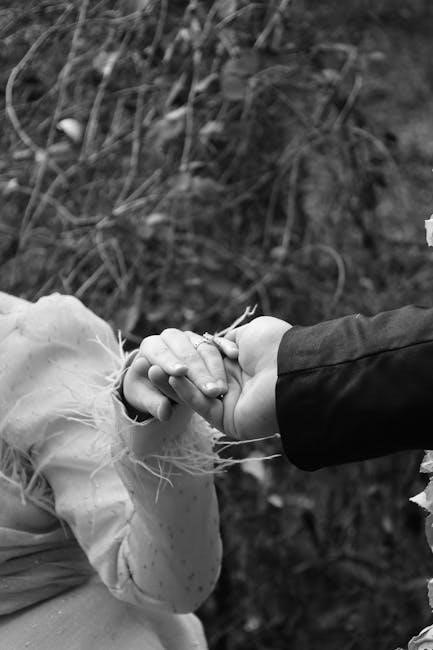Overview of Mendelssohn’s Wedding March
Felix Mendelssohn’s “Wedding March,” originating from “A Midsummer Night’s Dream,” is a globally recognized piece. Often played on the organ, sheet music is widely available, including free PDFs and paid options for various instruments.

History and Origin
Composed as part of incidental music for Shakespeare’s “A Midsummer Night’s Dream” (Op. 61), Mendelssohn’s “Wedding March” wasn’t instantly a wedding staple. Its popularity grew over time, eventually becoming a ubiquitous part of wedding ceremonies worldwide.
From A Midsummer Night’s Dream
The “Wedding March” is extracted from Felix Mendelssohn’s Op. 61, a collection of incidental music crafted to accompany William Shakespeare’s enchanting play, “A Midsummer Night’s Dream.” Mendelssohn, commissioned to write the music, captured the whimsical and celebratory essence of the play in his compositions. The suite includes various pieces, and the “Wedding March” is arguably the most famous among them. Its initial purpose was not exclusively for weddings, but rather to enhance the overall theatrical experience of Shakespeare’s comedy.
The play itself is a fantastical tale of love, magic, and mistaken identities, set in a mystical forest. Mendelssohn’s music aimed to complement these themes, adding depth and emotion to the narrative. “A Midsummer Night’s Dream” premiered in 1843, solidifying Mendelssohn’s reputation as a brilliant composer. The “Wedding March,” with its joyful and triumphant melody, perfectly encapsulated the celebratory atmosphere found within the play, although its association with marriage ceremonies evolved later.
Popularity at Weddings
While initially composed for Shakespeare’s “A Midsummer Night’s Dream,” the “Wedding March” gained immense popularity as a wedding processional. Its association with weddings began after Princess Victoria and Prince Frederick William of Prussia used it in their 1858 wedding. This royal endorsement significantly boosted its popularity. The triumphant and joyful nature of the piece made it ideally suited to celebrate the union of two individuals.
The “Wedding March” provides a sense of grandeur and tradition, becoming a staple in wedding ceremonies across various cultures. The accessibility of sheet music for various instruments, including piano, organ, and orchestral arrangements, helped spread its use. Many couples still prefer the “Wedding March” over other processional pieces due to its familiarity and uplifting melody. It represents a classic, timeless choice, symbolizing the start of a new chapter in a couple’s lives. Its enduring appeal ensures its continued presence in wedding celebrations for years to come.

Sheet Music Availability
The “Wedding March” sheet music is widely accessible. Options range from free PDF downloads for various instruments to paid versions offering enhanced arrangements and features. These resources cater to different skill levels and instrumental preferences.
Free PDF Downloads
Numerous websites offer free PDF downloads of the “Wedding March” sheet music. These downloads cater to various instruments, including piano, violin, flute, and others. Arrangements range from solo performances to ensemble pieces. Many sites provide printable scores, allowing musicians to access the music quickly and easily.
Free PDF versions are often available for different skill levels, from beginner to advanced. Some sites offer simplified arrangements for novice players, while others provide the original, more complex score. These free resources make the “Wedding March” accessible to a wide range of musicians.
Keep in mind that the quality of free sheet music can vary. Some versions may contain errors or be poorly formatted. However, many reputable websites offer high-quality, free PDFs that are suitable for performance and practice. Always preview the sheet music before downloading to ensure it meets your needs.
These free options provide an excellent starting point for anyone interested in learning or performing this classic wedding piece. Remember to check for copyright restrictions before using any downloaded sheet music for public performance.
Paid Sheet Music Options
For those seeking professionally arranged and meticulously transcribed versions of the “Wedding March,” several reputable music publishers offer paid sheet music options. These often include enhanced features such as fingering suggestions for piano, bowing markings for strings, and transposed parts for various instruments.
Paid sheet music frequently boasts superior print quality and accuracy compared to free downloads. Publishers ensure that the scores are free from errors and adhere to professional engraving standards. Furthermore, purchasing sheet music supports composers and arrangers, enabling them to continue producing high-quality musical resources.
Numerous online retailers, such as Sheet Music Direct and JW Pepper, offer digital downloads and physical copies of the “Wedding March” sheet music. These platforms provide a vast selection of arrangements for diverse instruments and skill levels.
Arrangements available through paid options may include piano solos, instrumental ensembles, vocal arrangements, and even versions for brass bands. These professional arrangements cater to specific performance needs and ensure a polished and refined musical experience. Consider paid options for important performances or when seeking the highest quality sheet music.

Instrumentation and Arrangements
The “Wedding March” transcends its original orchestral setting. Adaptable arrangements exist for solo piano, organ, and various instrumental ensembles. These versions cater to different skill levels and performance contexts, offering diverse musical interpretations.
Piano Solo Arrangements
The enduring appeal of Mendelssohn’s “Wedding March” has led to countless piano solo arrangements. These adaptations range from simplified versions for beginner pianists to more complex, virtuosic interpretations for advanced players. Accessibility is a key feature, allowing pianists of varying skill levels to perform this iconic piece.
Many arrangements focus on capturing the essence of the orchestral score within the limitations of a single instrument. Some transcriptions prioritize melodic clarity, while others emphasize harmonic richness and rhythmic drive. These arrangements are perfect for church performances, informal gatherings, or solo recitals.
Sheet music for piano solo arrangements is readily available online, with options for free downloads and paid publications. Performers can choose arrangements that best suit their technical abilities and musical preferences. Exploring different versions allows for personalized interpretations of this timeless classic.
The availability of numerous piano solo arrangements ensures that Mendelssohn’s “Wedding March” continues to resonate with pianists and audiences alike, celebrating love and joy through music.
Arrangements for Other Instruments
Beyond the ubiquitous piano solo arrangements, Mendelssohn’s “Wedding March” has been adapted for a diverse range of instruments and ensembles. The melody’s inherent beauty and celebratory character lend themselves well to various instrumental interpretations. String quartets, brass bands, and solo instruments like the violin, flute, and trumpet have all embraced this iconic piece.
Arrangements for string quartet often emphasize the lyrical qualities of the melody, creating an elegant and refined atmosphere. Brass band arrangements, on the other hand, capitalize on the grandeur and power of the ensemble, producing a festive and triumphant sound. Solo instrument arrangements showcase the virtuosity of the performer, highlighting the melody’s expressiveness.
Sheet music for these diverse instrumental arrangements can be found online and in print, catering to musicians of all levels and preferences. Whether it’s a flute solo, a trumpet duet, or a full orchestral arrangement, the “Wedding March” continues to inspire musicians to explore its melodic and harmonic possibilities.
The widespread availability of these arrangements ensures that Mendelssohn’s masterpiece remains a beloved choice for weddings and celebrations worldwide, transcending instrumental boundaries.
Musical Analysis
The “Wedding March” is typically in C major, offering a bright and joyful feel. Its allegro tempo contributes to its celebratory nature. The structure often features clear sections, making it easily recognizable and adaptable.
Key and Tempo
Mendelssohn’s “Wedding March” is traditionally notated in the key of C major, a key often associated with brightness and joy, perfectly fitting for a wedding celebration. This key provides a sense of optimism and resolution, which are desirable qualities for such an occasion.
The tempo of the piece is typically marked as Allegro, which translates to “fast” or “lively.” This brisk tempo contributes to the march’s energetic and celebratory character. The combination of C major and an Allegro tempo helps create a sense of forward momentum and excitement, appropriate for a processional.
The consistent key and tempo contribute to the piece’s accessibility and memorability, making it easily recognizable and enjoyable for a wide audience, regardless of their musical background. These elements, carefully chosen by Mendelssohn, play a significant role in the enduring popularity of the “Wedding March.” The clear tonality and upbeat tempo enhance the overall celebratory atmosphere.
Structure and Form
The “Wedding March” follows a relatively straightforward structure, contributing to its immediate appeal and recognizability. It generally adheres to a ternary form, often represented as A-B-A, where a primary theme (A) is followed by a contrasting section (B), before returning to the original theme (A).
The A sections are characterized by their majestic andProcessional nature, featuring memorable melodies and clear harmonic progressions in C major. These sections are typically more assertive and rhythmically driven, establishing the celebratory mood. The B section provides a contrast, often being more lyrical and subdued, offering a brief respite from the grandeur of the A sections.
The return of the A section reinforces the initial theme and brings the piece to a triumphant conclusion. This structure, combined with Mendelssohn’s masterful orchestration, creates a sense of balance and resolution. The clear structure ensures that the piece is both memorable and emotionally satisfying, contributing to its lasting appeal.

Notable Performances and Recordings
The “Wedding March” boasts countless performances and recordings, solidifying its place in musical history. Its ubiquitous presence at weddings worldwide has made it one of the most frequently performed pieces of classical music. Renowned orchestras and musicians have recorded versions, each bringing their unique interpretation to Mendelssohn’s masterpiece.
Organ performances are particularly notable, given the piece’s traditional association with church weddings. Recordings featuring celebrated organists showcasing the instrument’s grandeur are widely available. Orchestral renditions often highlight the rich textures and dynamic contrasts inherent in Mendelssohn’s original score. Furthermore, various arrangements for different instruments and ensembles have led to diverse and innovative recordings.
From historical recordings that capture the piece’s early popularity to contemporary interpretations that explore its versatility, the “Wedding March” continues to inspire and captivate audiences. These performances and recordings serve as a testament to the enduring appeal and timeless beauty of Mendelssohn’s creation, ensuring its continued presence in weddings.

